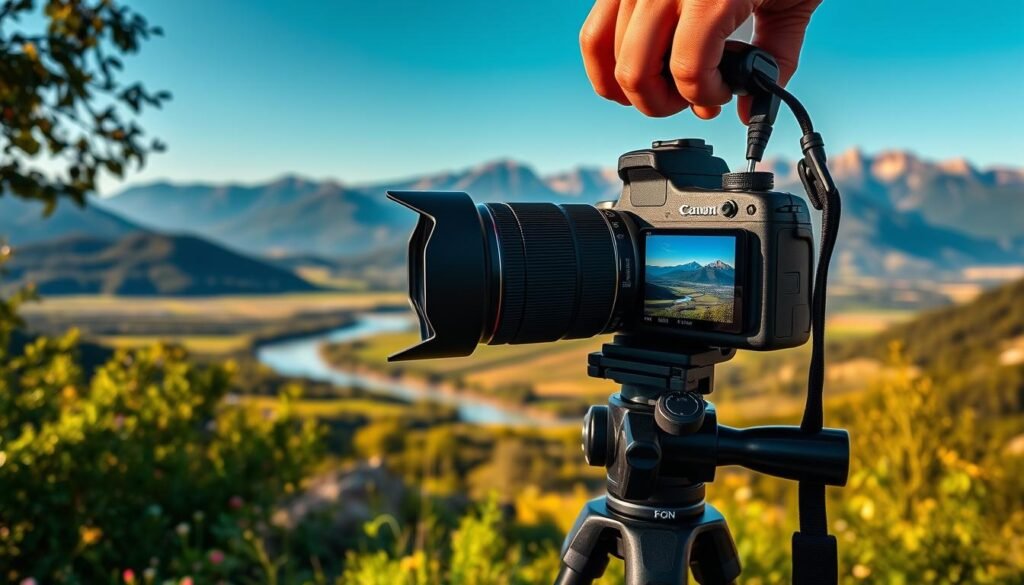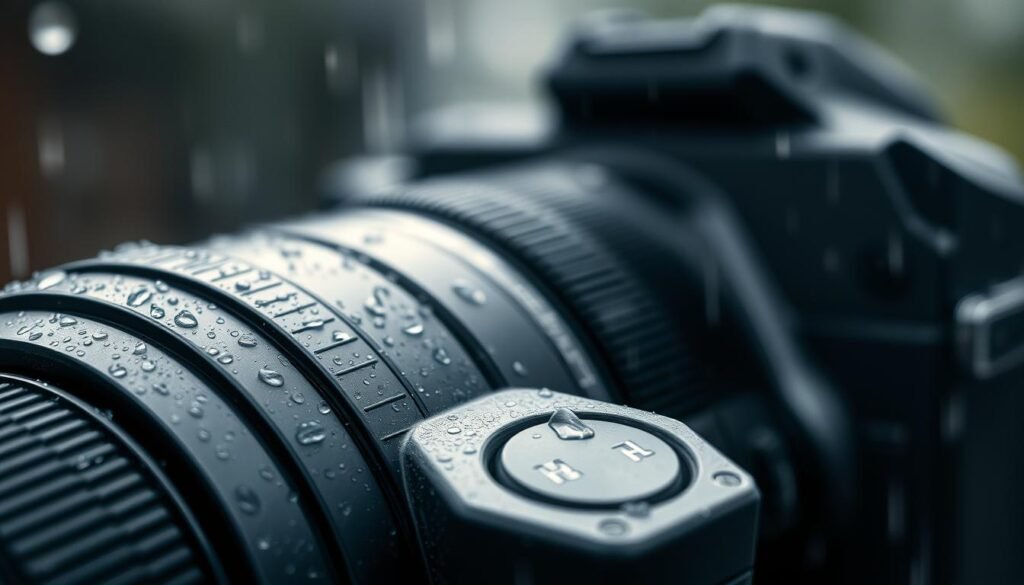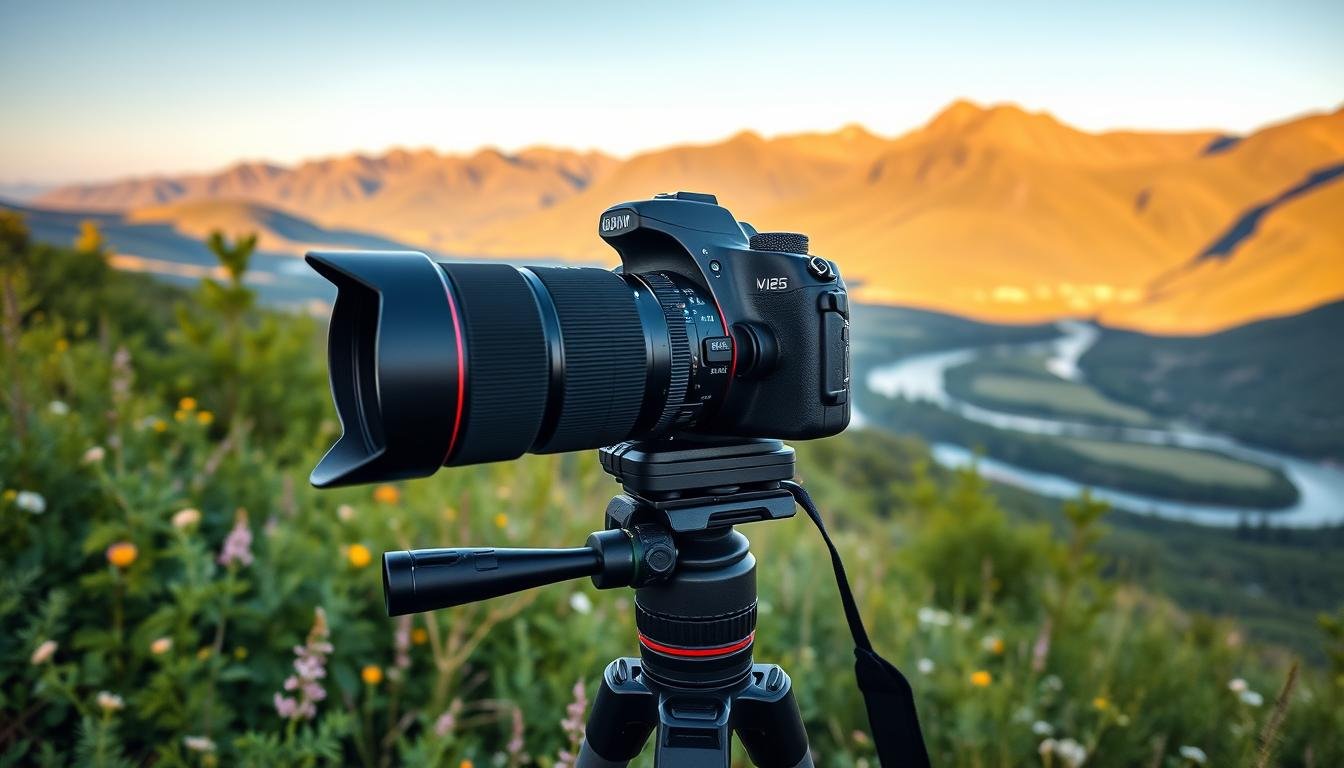The right camera is key to stunning landscape photos. A good guide can help you choose the best photography gear. The right camera can transform your landscape shots into breathtaking images.
We’ll look at what to consider when picking a camera for landscapes. We’ll cover the importance of gear and camera features. This guide, Best Camera For Landscape Photography, is for new and experienced photographers. It will help you choose the best camera for your landscape photos.

Key Takeaways
- Investing in a good camera is crucial for capturing high-quality landscape photography
- A camera buying guide can help you navigate the various photography equipment options
- Understanding camera features is essential for making an informed decision
- Landscape photography requires a camera with good image quality and resolution
- Considering the type of photography equipment you need is vital for your specific needs
- A good camera for landscape photography should have the right balance of features and price
- Researching and comparing different camera options is key to finding the best camera for your needs
Understanding Landscape Photography Requirements
Landscape photography is all about capturing the perfect shot. Dynamic range is key to showing details in bright and dark areas. A camera with high resolution is also crucial for clear images.
Weather sealing is another important factor. It keeps the camera safe from rain, snow, and extreme temperatures. This is vital for shooting outdoors.
Other important camera features include a wide-angle lens and image stabilization. These help capture the landscape’s vastness and beauty. A high-quality sensor ensures sharp images.
When choosing a camera for landscape photography, consider these factors. A camera with the right dynamic range, resolution, weather sealing, and features will elevate your photos.
Some key considerations for landscape photography are:
- High dynamic range to capture details in both bright and dark areas
- Good resolution for clear and detailed images
- Weather sealing to protect the camera from the elements
- Wide-angle lens for capturing the vastness of the landscape
Key Features to Look for in Landscape Photography Cameras
The right camera features are crucial for landscape photography. A full-frame sensor camera offers better low-light shots and a shallower depth of field, and a high-quality lens greatly improves image quality.
Look for a camera with image stabilization to reduce camera shake and blur. A wide dynamic range is key for capturing all the tones in a scene. Weather sealing is also vital to protect your camera from the elements.
Other important features include a high-resolution sensor, fast autofocus, and good battery life. Here are some key features to consider:
- Full-frame sensor
- High-quality lens
- Image stabilization
- Wide dynamic range
- Weather sealing
You can find a camera that suits your needs by focusing on these features. It will help you take stunning photos with great image quality.
Best Camera for Landscape Photography: Top Picks for 2025
Choosing the right camera is key for stunning landscape photos. With many options, picking the best can be tough. We’ll look at the top picks for 2024, covering full-frame, mirrorless, DSLR, and budget-friendly cameras.
When searching for the best camera, focus on important features. Look for high image quality, weather sealing, and a wide dynamic range. Full-frame cameras are great for landscapes because of their top-notch image quality and wide-angle shots.
Here are some top picks for landscape photography cameras:
- Nikon Z7 II: A full-frame mirrorless camera with excellent image quality and weather-sealing
- Canon EOS 5D Mark IV: A full-frame DSLR camera with a wide dynamic range and high image quality
- Sony Alpha a7R IV: A full-frame mirrorless camera with excellent image quality and fast autofocus
- Fujifilm X-T4: A mirrorless camera with a wide dynamic range and excellent video capabilities
- Canon EOS Rebel T8i: A budget-friendly DSLR camera with good image quality and features
- Sony Alpha a6400: A budget–friendly mirrorless camera with fast autofocus and good image quality
Understanding Sensor Sizes and Their Impact
The camera’s sensor size is key to stunning landscape photos. A bigger sensor size means better light capture, which leads to higher image quality and more camera features. Full-frame sensors are often the top choice for landscape photography because they capture a wider range of light and details.
The size of the camera’s sensor affects how good the images are. For example, full-frame sensors are better than APS-C or micro-four-thirds ones. This is because they are larger and work better in low light. But, the right sensor size depends on the photographer’s needs and the camera’s features.

A bigger sensor size can also make the camera work better. For instance, a full-frame camera might have better autofocus and metering. This means sharper images and more accurate exposures. When picking a camera for landscape shots, consider the sensor size and its effect on image quality and features.
When choosing a camera, consider your style of photography, the amount of detail you need, and the features you must have. Knowing how sensor size affects image quality helps photographers pick the right camera, ensuring they can take amazing landscape photos.
Essential Accessories for Landscape Photography
The right accessories are key to amazing landscape photos. A tripod is vital for sharper images and better camera control. Filter systems boost colors and contrast. A good camera bag keeps your gear safe and easy to carry.
Choosing the best accessories depends on your photography style. If you shoot in bad weather, pick a sturdy tripod and bag. Filter systems are also great for reducing glare and improving image quality.
Don’t forget a remote shutter release, lens cleaning kit, and spare battery. These ensure you’re ready to capture the best shots. With the right gear, like a tripod, filters, and bags, your landscape photos will look pro.
- Tripod: Manfrotto or Gitzo
- Filter systems: Lee or Singh-Ray
- Camera bags: Lowepro or Think Tank
Using the right accessories can boost your landscape photography. You’ll take stunning photos that show off your creativity.
Weather Resistance and Durability Factors
When you’re into landscape photography, weather resistance is key. Cameras that can handle rain, snow, or extreme heat are necessary. They let you capture amazing shots in all kinds of weather.
Durability is also important. A tough camera can take a beating and still keep going. Features like a strong build and a solid shutter help it last longer.
Here are some things to look at when checking a camera’s weather and durability:
- Weather-resistant seals and gaskets
- Durable materials, such as magnesium alloy or carbon fiber
- A reliable shutter mechanism and shutter count
By focusing on these, you can pick a camera that’s up for the challenge of landscape photography. It will give you top-notch photos for years.

Ultimately, a weather-tough and durable camera with great features will give you the best shots in landscape photography.
Price Range Considerations
Choosing a camera for landscape photography means looking at the price. Cameras can cost from a few hundred to several thousand dollars. Knowing what each price range offers helps you decide.
A camera’s price range depends on its features, quality, and brand. For instance, an entry-level camera is cheaper because it has basic features and lower image quality. A professional-grade camera costs more because it has advanced features and better image quality.
Entry-Level Options
Entry-level cameras, which cost between $500 and $1000, are great for beginners or those with a small budget. They have basic features like manual mode and decent image quality. Cameras like the Canon EOS Rebel and the Nikon D3500 are popular in this range.
Mid-Range Choices
Mid-range cameras cost between $1000 and $2500 and offer more features and better image quality than entry-level ones. They offer weather sealing, faster autofocus, and higher ISO ranges. Cameras like the Sony Alpha a6400 and the Fujifilm X-T4 are in this range.
Professional Grade
Professional-grade cameras are for serious photographers. They offer the best image quality and features. They cost over $2500 and have full-frame sensors, advanced autofocus, and weather sealing. Examples include the Nikon D850 and the Canon EOS 5D Mark IV.
Image Quality and Resolution Requirements
Image quality is key in landscape photography. The resolution, measured in megapixels, greatly affects the photo’s quality. A higher megapixel count means a clearer, more detailed image, perfect for landscapes.
A camera’s ability to handle a wide dynamic range is also vital. This means it can capture both bright and dark areas in one shot, resulting in a more natural and detailed photo. Plus, low-light performance is crucial for taking stunning photos in tough lighting.
When checking a camera’s image quality and resolution, consider these:
- Sensor size and type
- Lens quality and aperture
- Image processing and noise reduction
Battery Life and Power Management
Battery life is key for landscape photography. A camera with a long battery life is vital for long shots. Power management helps save battery and keeps your camera going all day.
Features like battery type, power-saving modes, and screen efficiency affect battery life. Knowing these helps you pick the right camera for your needs.
Here are tips for saving power during long shoots:
- Turn off Wi-Fi and Bluetooth when not needed
- Use the camera’s power-saving modes
- Carry extra batteries or a portable power bank
Choosing a camera with good battery life and power management is smart. It ensures you have a reliable tool for amazing landscape photos. Also, features like weather sealing and durability add to a better shooting experience.
Camera Body Weight and Portability
In landscape photography, camera body weight and portability matter a lot. A lighter camera makes a big difference, especially when you’re hiking or doing travel photography. You want a camera that’s easy to carry so you can focus on taking amazing photos.
The weight and size of a camera affect how easily you can move. This is key for catching quick moments in landscape photography. For example, a small, light camera is perfect for long hiking trips. It’s great for outdoor lovers.
When looking at a camera’s portability, consider its size, weight, and how it feels in your hand. Choose a camera that’s strong but not too heavy. Also, consider the weight and size of any extra stuff you might need, like lenses or tripods.
You’ll have a better time shooting by picking a camera that’s both good for photos and easy to carry. This is true whether you’re hiking in the mountains or doing travel photography in new places.
FAQ
What are the key requirements for landscape photography?
Landscape photography needs a camera that can handle a wide range of tones. It also requires high resolution for detailed shots. Plus, weather sealing is key to protecting your camera from harsh outdoor conditions.
What are the top features to look for in a landscape photography camera?
Look for a camera with a large sensor, high-quality lenses, and image stabilization. Advanced autofocus is also important. These features help capture sharp images in any lighting.
How do sensor sizes impact image quality in landscape photography?
Sensor size is crucial for landscape photography. Larger sensors capture more light, offering better dynamic range and low-light performance. Full-frame sensors are the best for landscape photography, providing superior image quality.
What essential accessories are recommended for landscape photography?
You’ll need a sturdy tripod, high-quality filters, and a durable camera bag. These accessories help capture sharper images and protect your gear in tough conditions.
How important is weather resistance and durability in a landscape photography camera?
Weather resistance and durability are key for landscape photographers. Look for cameras that can withstand rain, snow, and dust without losing performance or image quality.
How do I determine the right price range for a landscape photography camera?
Your budget and desired features will guide your choice. Entry-level cameras cost $500-$1000 and offer basic features. Mid-range cameras ($1000-$2500) and professional-grade cameras ($2500+) have more advanced features.
What image quality and resolution factors are important for landscape photography?
For landscape photography, focus on megapixel count, dynamic range, and low-light performance. Higher megapixels mean larger prints and more post-processing options. Good dynamic range and low-light capabilities are essential for capturing outdoor scenes.
How important is battery life and power management for landscape photography?
Battery life and power management are vital for long shooting sessions. Choose cameras with efficient power consumption and long-lasting batteries. Features like USB charging or external power banks are also helpful.
What weight and portability factors should I consider for a landscape photography camera?
Weight and portability are key, especially for hiking or traveling. Choose a lightweight camera and lenses that offer high image quality and features.
Conclusion: Choosing Your Ideal Landscape Photography Camera
Starting your journey in landscape photography means picking the right camera, which is key. The landscape photography cameras we’ve talked about have special features for outdoor shots. Look for a camera with great image quality, dynamic range, and weather-sealing to make your photos stand out.
But remember, the camera is only part of the story. You also need a strong tripod, good filters, and a comfy camera bag. By thinking about these things, you’ll find the perfect camera for you. This way, you can capture the stunning views that excite you.
As a tech writer specializing in gadget apps and software, my mission is to make complex technical details accessible and engaging, helping users navigate modern technology with confidence, from early adopters to everyday consumers.
I focus on creating clear and concise documentation, tutorials, and articles that demystify how apps and software integrate with gadgets to enhance daily life. Whether it’s breaking down the features of a smart home app, exploring the latest mobile software updates, or providing troubleshooting guides for wearable tech, I aim to make the user experience seamless and enjoyable.
Writing is more than conveying information; it fosters understanding and connection. By simplifying gadgets, apps, and software, I empower users to use technology for productivity, entertainment, and innovation in their daily lives.

